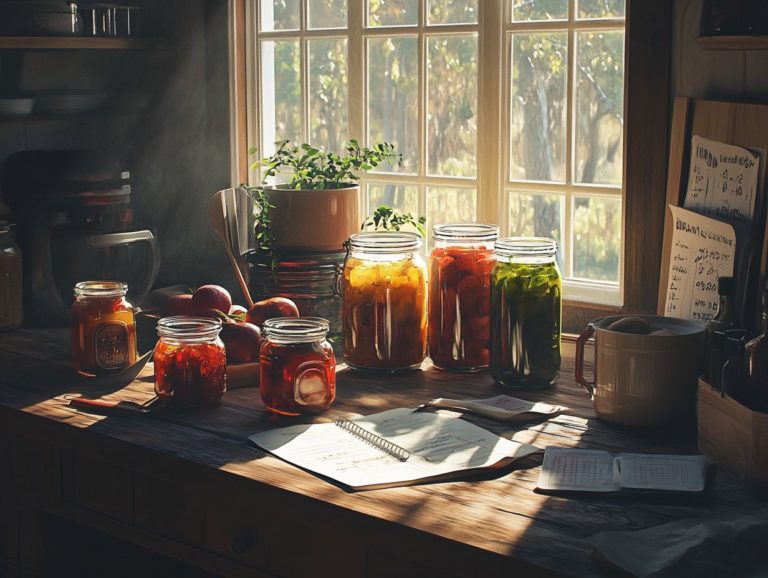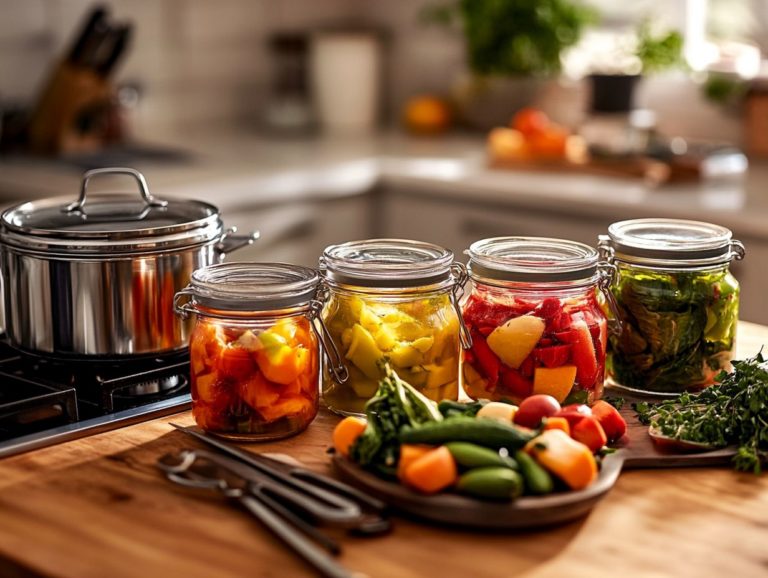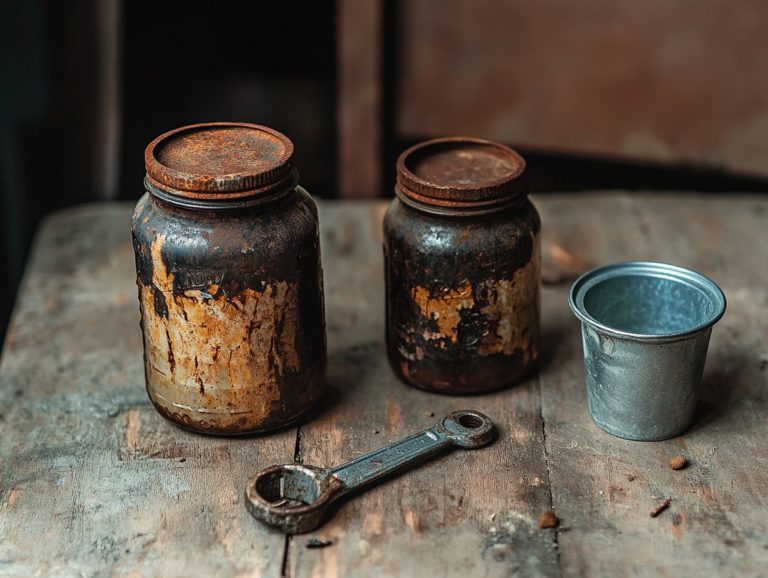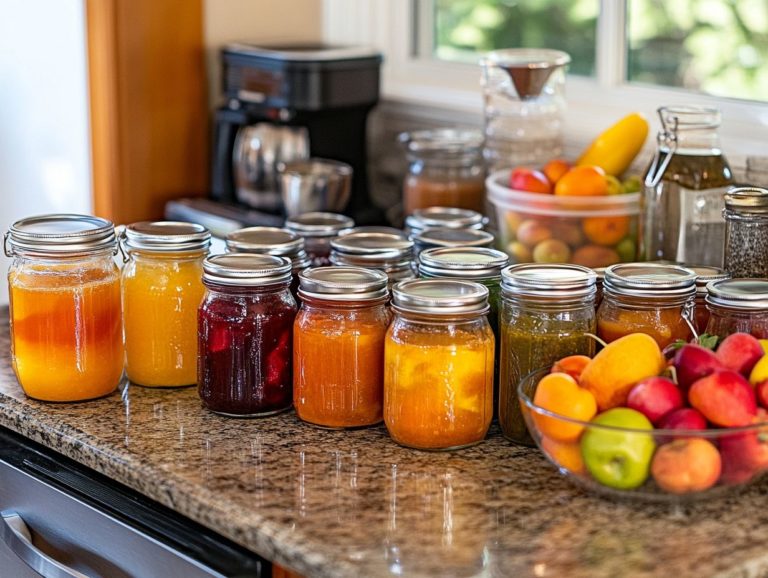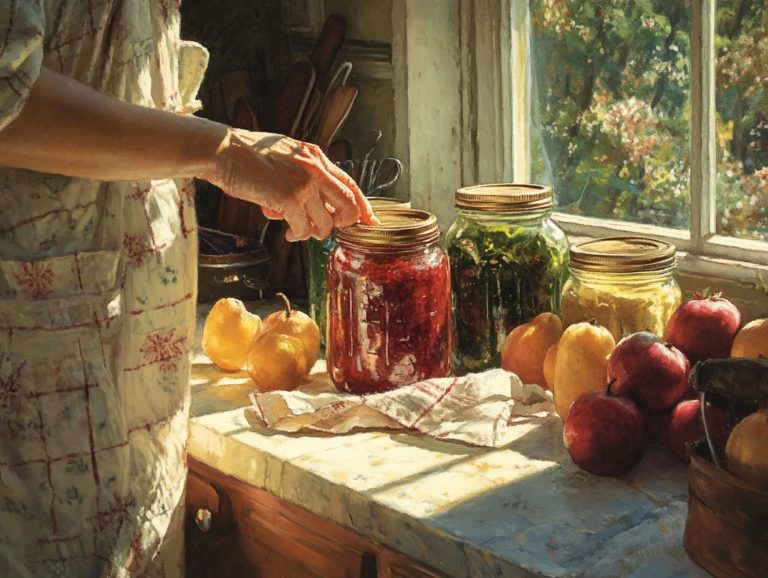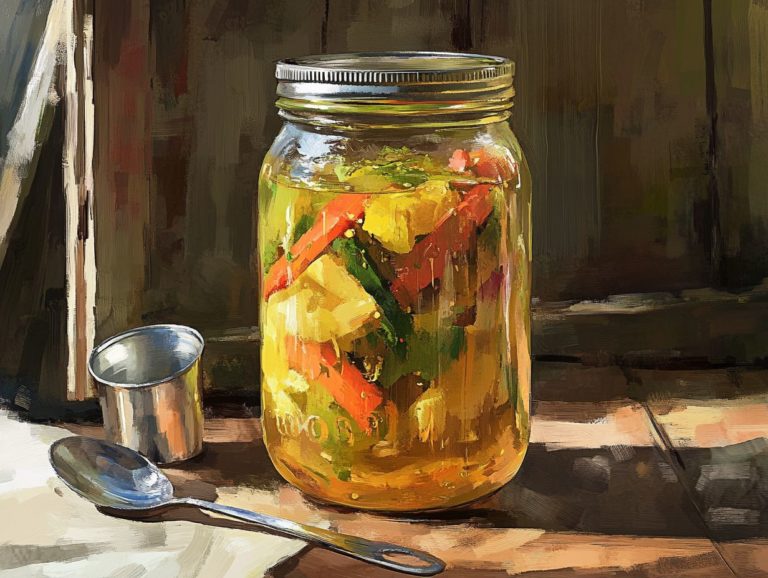Canning Overflows: Prevention Methods
Canning can be a rewarding endeavor, allowing you to preserve your favorite foods. However, it certainly comes with its challenges one of the most frustrating being those pesky canning overflows.
Understanding what triggers these spills and the potential risks they present is essential for a successful canning experience. This guide will equip you with prevention techniques, proper jar preparation methods, and best practices to help you minimize any messy mishaps.
Whether you re a seasoned canner or just embarking on this culinary journey, these tips will ensure your efforts yield delicious and safe results.
Contents
- Key Takeaways:
- Understanding Canning Overflows
- The Importance of Preventing Overflows
- Preventing Overflows in the Canning Process
- Dealing with Overflows During Canning
- Tips for Avoiding Canning Overflows
- Frequently Asked Questions
- What causes canning overflows?
- What is the recommended headspace for canning to prevent overflows?
- How can I prevent overflows when canning high-acid foods?
- What can I do if my jar overflows during processing?
- Are there any other methods to prevent canning overflows?
- Do Different Types of Canning Jars Affect Overflows?
Key Takeaways:
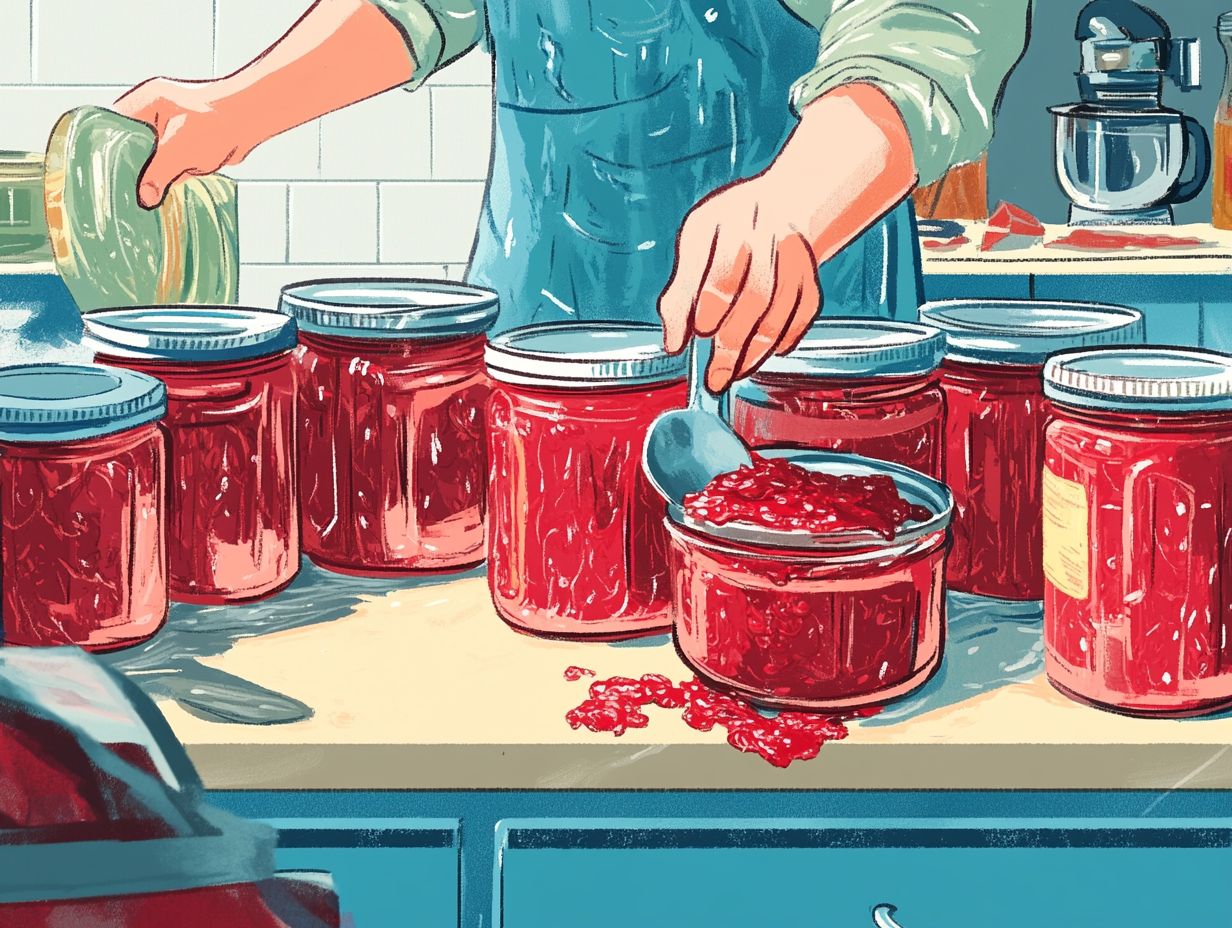
- Proper jar preparation and filling techniques can help prevent canning overflows.
- Adjusting processing time and pressure according to the recipe can also prevent overflows.
- Avoid common mistakes and follow best practices to successfully prevent canning overflows.
Understanding Canning Overflows
Understanding canning overflows is crucial for anyone passionate about preserving food effectively through home canning methods. To ensure success, it’s important to learn how to avoid common canning errors, as overflows can occur during the canning process, affecting both the quality and safety of your canned goods.
By examining factors like liquid loss during heat processing and the importance of proper jar sealing, you can discover the best ways to minimize overflow risks. This in-depth analysis will explore the causes and consequences of canning overflows, offering valuable insights for both novice and seasoned canners, including tips on common canning errors and how to fix them.
What Causes Canning Overflows?
Canning overflows can happen for a variety of reasons. It’s essential to recognize these causes and learn how to handle overfilled canning jars to safeguard your food preservation efforts.
Improper handling of jars and temperature inconsistencies during processing are often the reasons behind overflows. You might find yourself overfilling jars beyond the recommended headspace the space between the food and the jar lid resulting in false seals or encountering temperature fluctuations that compromise your pressure canner s performance.
One crucial aspect to consider is how boiling water interacts with jar contents. When jars are filled too high, the contents can expand and bubble over. Sudden temperature changes can also lead to uneven pressure within the canner, worsening the situation.
Low-acid foods like green beans and corn are particularly susceptible because their density increases the likelihood of overflow if not managed with care. Maintaining a consistent temperature throughout the canning process is essential, as it ensures that food is sealed effectively without jeopardizing safety or quality.
By focusing on these details, you can significantly reduce the chances of messy and unsafe canning outcomes.
The Importance of Preventing Overflows
Preventing canning overflows is vital for savoring delicious homemade goods! When overflows happen, they jeopardize the vacuum seal of jars, heightening the risk of food spoilage and the presence of harmful bacteria like Botulism. For more insights, check out canning techniques troubleshooting tips.
Thus, grasping the importance of proper jar sealing techniques and effective food preservation methods is essential for anyone venturing into home canning.
Potential Risks and Consequences
The potential risks and consequences of canning overflows are serious and deserve your full attention. A compromised vacuum seal can lead to food spoilage and create a breeding ground for harmful bacteria like Botulism.
That’s why it s crucial for you, as a home canner, to understand and mitigate these risks through meticulous jar preparation and cleaning. To minimize such hazards, ensure that every jar is thoroughly cleaned and inspected for cracks or chips before you use them.
Reliable jar lids are essential for achieving a secure seal, preventing air from entering and bacteria from thriving. By following the recommended processing times accurately, you further safeguard against overflow incidents.
By prioritizing these safety measures and adhering to best canning practices, you can significantly reduce the likelihood of encountering issues that might compromise the integrity of your preserved foods. Your commitment to these details not only ensures your safety but also enhances the quality of your canning efforts.
Preventing Overflows in the Canning Process

To prevent overflows during the canning process, you need to master a blend of suitable canning methods and canning techniques for beginners that focus on meticulous jar preparation.
By understanding the differences between raw and hot packing and ensuring you have the correct processing times and pressure settings in your pressure canner, you can significantly minimize the risk of overflow while maximizing your food preservation success.
Proper Jar Preparation and Filling Techniques
Proper jar preparation and filling techniques are essential for ensuring that your jars seal correctly and prevent any canning mishaps. This means giving your jars a good scrub, accurately measuring the space at the top of the jar to avoid overfilling, and securely attaching jar lids to create a reliable vacuum seal.
To start, wash your jars with hot, soapy water, rinsing them well to eliminate any residues. After that, inspect for chips or cracks; these imperfections can hinder the sealing process.
Once your jars are cleaned, heating them in boiling water helps to sterilize and keep them warm. When it s time to fill the jars, pay close attention to the space at the top of the jar; leave the recommended space typically around one inch to accommodate food expansion and prevent spills.
Using a funnel can enhance precision during filling. After filling the jars, wipe the rims to ensure a clean surface for the lids to adhere properly. This step is vital for forming an airtight seal and guaranteeing preservation, so you can enjoy your canned goods with confidence.
Adjusting Processing Time and Pressure
Adjusting processing time and pressure is essential for your canning success, particularly when using a pressure canner. Any fluctuations in temperature during the heat processing can lead to improper sealing and potential overflow. It s vital to adhere to the recommended guidelines for boiling water and pressure adjustments.
These guidelines aren’t just suggestions; they ensure that food is heated sufficiently to eliminate harmful bacteria, enzymes, and spoilage organisms. Different types of food whether it s fruits, vegetables, or meats require specific processing times and pressures to guarantee safety and quality. Even a slight variation in temperature can throw off the entire canning process, putting you at risk of under-processing your food, which could lead to health hazards.
Paying careful attention to each step in the canning method preserves the delightful flavors and nutritional value of your food and acts as your safeguard against spoilage and foodborne illnesses.
Dealing with Overflows During Canning
Managing overflows during canning can feel overwhelming, but grasping the right steps can significantly reduce the risks linked to excessive canning liquid during bottling.
When an overflow happens, act fast! Quick fixes can save your delicious canned goods. It s essential to tackle any jar sealing issues right away. This swift action helps maintain a proper vacuum seal, ensuring both the safety and quality of your canned fruits and other foods.
How to Handle Jars with Overflowing Contents
Handling jars that are overflowing with contents demands your immediate attention to ensure food safety and effective preservation. Start by carefully cleaning the jars and adjusting the lids, as overfilling can compromise the sealing process and lead to spoilage.
First, remove the jars from their storage area and assess the extent of the overflow, doing so with a steady hand to prevent further spillage. Once you ve evaluated the situation, grab a damp cloth and gently clean the rims and lids to eliminate any residue that could obstruct a proper seal. This step not only restores cleanliness but also removes potential contaminants, safeguarding the integrity of the food inside.
Don t overlook the importance of inspecting the jar lids for any damage; even the smallest imperfection can allow air to seep in, causing spoilage. Addressing any overfilling promptly is crucial, as it maintains the preservation process and extends the shelf life of the contents, ensuring they remain safe and delicious for your future enjoyment.
Tips for Avoiding Canning Overflows

You can easily avoid canning overflows by following best practices and being aware of common mistakes that may happen during the home canning process, including fixing the issue of canning liquid loss.
By focusing on proper jar sealing techniques and paying close attention to details at every stage, you will greatly reduce the risk of overflow and achieve successful food preservation.
Common Mistakes to Avoid
Common mistakes in the canning process can lead to disastrous outcomes, especially when overfilling jars or creating incorrect seals. Recognizing these pitfalls is crucial for anyone involved in food preservation to ensure that your jars seal properly and remain safe to eat.
One critical mistake is not cleaning the rims of your jars before sealing. This can prevent a proper airtight closure. It s essential to leave adequate headspace (the empty space between the food and the lid) to allow for expansion during processing. Overlooking this detail can lead to failed seals. Also, testing lids for flexibility and ensuring they are free from cracks or defects will help avoid unnecessary waste.
Paying attention to these details will boost your canning success and help you enjoy delicious, safe food!
Best Practices for Successful Canning
Implementing best practices for successful canning is essential for home canners aiming to preserve food effectively. This involves mastering various canning methods, ensuring your jars are sealed correctly, and understanding how to maintain a vacuum seal (the airtight closure that keeps food fresh) throughout the process.
It’s also beneficial to understand the specifics of pressure canning and water bath canning, as each method is suited for different types of foods. Pay close attention to details like using the right lids and inspecting jars for dings or dents, as these can greatly affect the long-term success of your food preservation efforts.
Make sure your jars are filled to the recommended headspace levels to prevent spoilage.
As important as achieving the perfect jar seal is understanding the science behind acidity levels in foods. This knowledge is vital for ensuring the safety and longevity of your canned goods.
Frequently Asked Questions
What causes canning overflows?
Canning overflows can be caused by several factors, including too much headspace in the jar, improper sealing, and incorrect processing time. For more information on canning storage issues, troubleshooting these problems can be very helpful.
What is the recommended headspace for canning to prevent overflows?
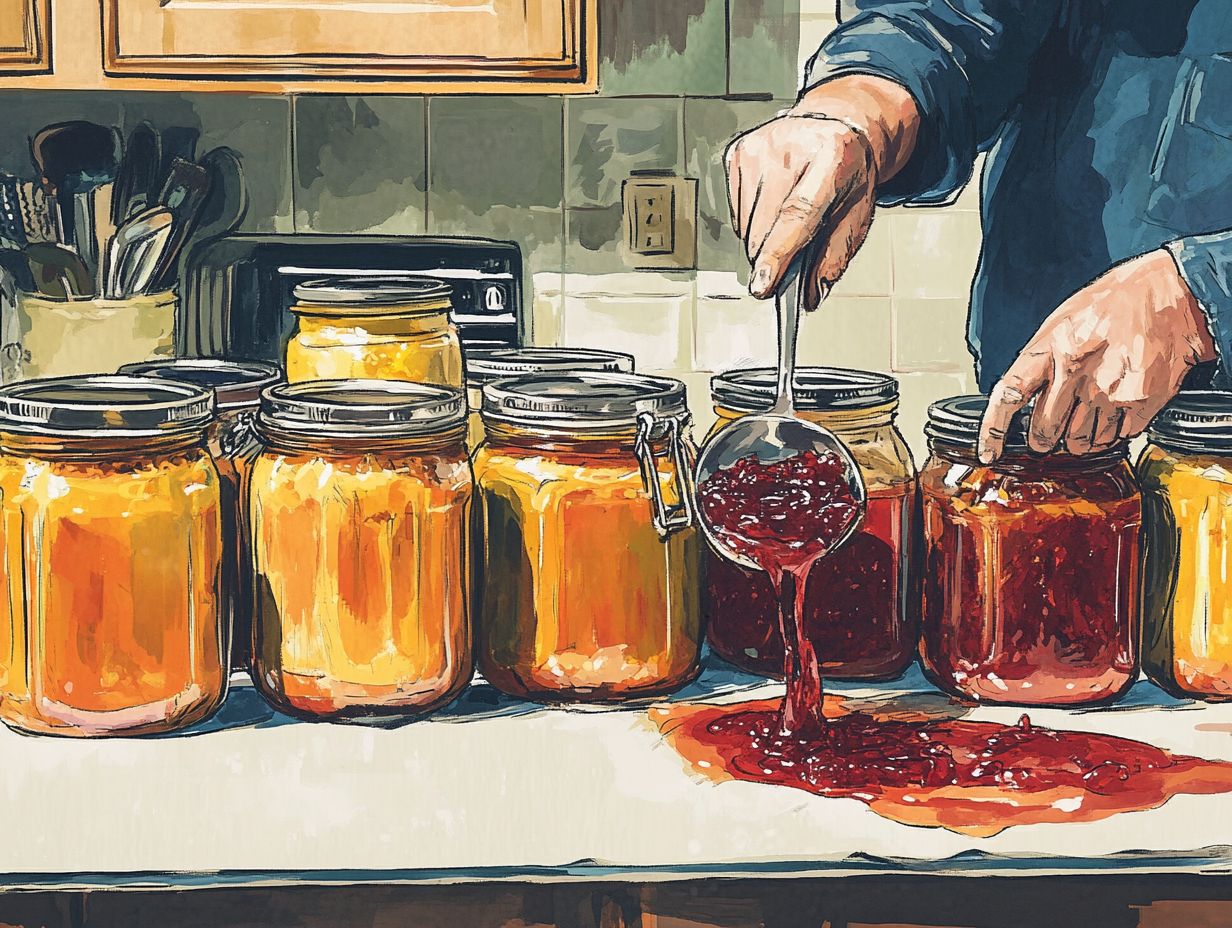
The recommended headspace for most canning recipes is usually 1/4 inch. This can vary based on the type of food being canned.
Always follow the recipe instructions to prevent overflows. This is especially important for dense foods like pasta sauces.
How can I prevent overflows when canning high-acid foods?
To prevent overflows when canning high-acid foods, leave 1/4 inch of headspace. Make sure the jar is sealed properly.
You can tap the jar gently on a flat surface before processing. This helps to remove air bubbles that may cause overflows.
Using a pressure regulator, which controls the pressure inside the canner, can help maintain optimal processing conditions.
What can I do if my jar overflows during processing?
If your jar overflows during processing, carefully remove it from the canner. Clean the rim and sealing area of the jar.
Then, reprocess the jar using the correct headspace and processing time. For additional help, consult resources like Pennsylvania State University or the National Center for Home Food Preservation.
Are there any other methods to prevent canning overflows?
Yes! You can prevent overflows by using a canning funnel to fill the jars. Avoid tilting or shaking the jars during filling.
Always follow the recommended processing time for the specific food you’re canning. Using Agee preserving jars can also improve your results.
Do Different Types of Canning Jars Affect Overflows?
Yes! Wide-mouth jars make it easy to fill without spilling. They also allow for the right space between the food and the jar lid, reducing overflow risks.
Jars designed specifically for canning help prevent overflows during processing. Explore how Zepp M jars could enhance your canning results!
Try using wide-mouth jars in your next canning project for a hassle-free experience!

